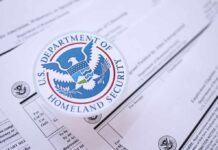
President Trump’s sweeping tariff plan hit a major roadblock when a federal court ruled he exceeded his authority, but the administration quickly secured a temporary reinstatement while preparing for a potential Supreme Court showdown.
At a Glance
- The U.S. Court of International Trade ruled Trump overstepped his authority in imposing sweeping tariffs on multiple countries
- The ruling halted a 30% tariff on China, 25% on certain goods from Mexico and Canada, and 10% on most other countries
- A federal appeals court granted an emergency motion to temporarily reinstate the tariffs while the case proceeds
- The administration is expected to pursue the case to the Supreme Court if necessary
- The court battle has weakened Trump’s leverage in using tariffs as a negotiation tool
Court Ruling Challenges Presidential Authority
The U.S. Court of International Trade delivered a significant blow to the Trump administration’s trade policy by ruling that the President exceeded his authority under the International Emergency Economic Powers Act of 1977 (IEEPA). The three-judge panel, appointed by Presidents Reagan, Obama, and Trump, found that the sweeping tariffs—30% on China, 25% on certain goods from Mexico and Canada, and 10% on most other countries—did not adequately address the threats they purported to combat. The court determined that Trump lacked the statutory authority to impose such broad measures without proper justification.
The ruling represents a rare judicial check on presidential trade powers, which have historically received substantial deference from the courts. However, the decision does not affect Trump’s other tariffs on cars, steel, and aluminum, which were imposed under Section 232 of the Trade Expansion Act of 1962—a different legal provision that gives the president broader authority to act on national security grounds. This creates a complex legal landscape where some tariffs remain in effect while others face judicial scrutiny.
The Trump administration has filed a notice that it is appealing the tariff ruling. The US Supreme Court may ultimately have the final say in the high-stakes case that could impact trillions of dollars in global trade.
The decision is one of the biggest setbacks in court for… pic.twitter.com/rojyqtMevs
— Special Situations 🌐 Research Newsletter (Jay) (@SpecialSitsNews) May 29, 2025
Swift Administration Response
The Trump administration moved quickly to counter the ruling, filing an immediate appeal and securing a temporary stay from a federal appeals court. This emergency motion allows the tariffs to remain in place while the case is litigated, with the next hearing scheduled for June 5. The administration’s legal team argued that “the political branches, not courts, make foreign policy and chart economic policy,” signaling their position that the judiciary should not interfere with executive decisions on international trade matters.
“America cannot function if President Trump, or any other president, for that matter, has their sensitive diplomatic or trade negotiations railroaded by activist judges.”, stated Karoline Leavitt.
President Trump himself expressed strong disagreement with the court’s decision, writing on social media: “Hopefully, the Supreme Court will reverse this horrible, Country threatening decision, QUICKLY and DECISIVELY.” His statement reflects the administration’s determination to pursue every legal avenue available, potentially taking the case to the nation’s highest court. Trump’s trade adviser Peter Navarro has already suggested alternative methods to impose tariffs if the current legal challenges prove unsuccessful.
US administration pushing to overturn US Court of International Trade decision to suspend tariffs imposed under the IEEPA, saying it would go to US Supreme Court as soon as Friday if a federal appeals court doesn't overturn the original rulinghttps://t.co/XfMaju6uGY
— Gregory Daco (@GregDaco) May 29, 2025
Impact on Trade Negotiations and Business
The court battle has introduced significant uncertainty into international trade relations and weakened Trump’s leverage in using tariffs as a negotiation tool. As the legal proceedings continue, trading partners may be less inclined to make concessions knowing that the tariff threats face judicial scrutiny. Goldman Sachs economist Alec Phillips noted, “This ruling represents a setback for the administration’s tariff plans and increases uncertainty but might not change the final outcome for most major U.S. trading partners.”
American businesses remain caught in the middle of this legal and political struggle. Many companies had already begun adjusting their supply chains and pricing strategies in anticipation of the higher tariffs. Now they face the prospect of continued “tariff whiplash” as the case moves through the courts. Business owners are seeking more certainty about future trade policies, even as the administration signals its determination to maintain a tough stance on imports regardless of the legal outcome.

























